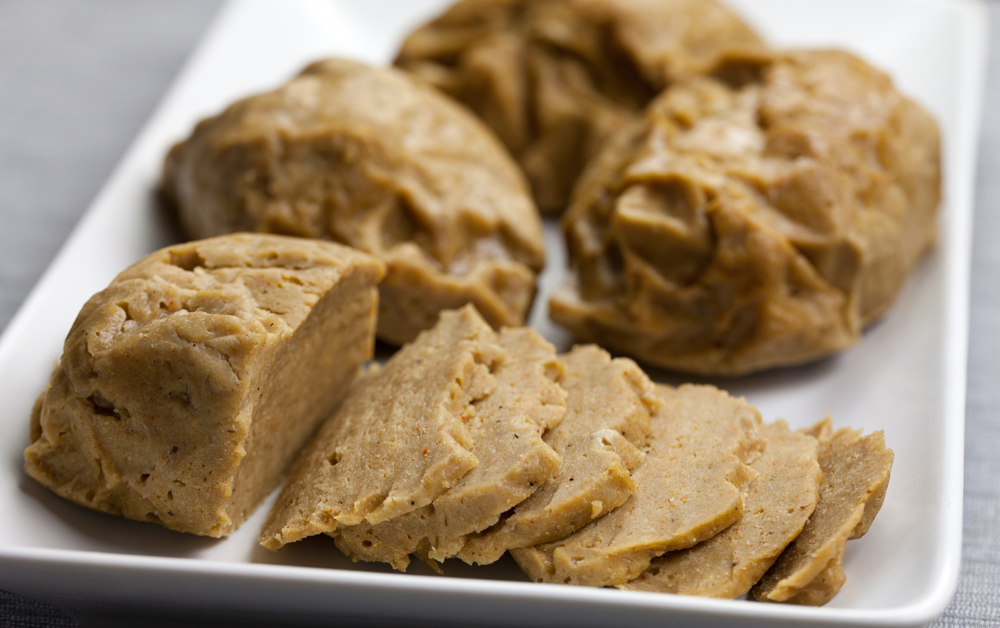Veggie meat replacement seitan is a popular choice for those who are vegan. An entirely gluten-free product has raised some worries regarding the potentially detrimental consequences of gluten consumption.
Contents
Amazing Seitan Nutrition Facts
Seitan, commonly mistaken for tofu or tempeh, is very distinct. In contrast to tofu and tempeh, Seitan is manufactured from gluten, the protein present in wheat after all the dough particles have been removed. Seitan is made from gluten, not soybeans.

Seitan Calories
How many calories are in a Seitan? The precise values may be seen below. Let’s try to understand the calorie content in grams in this vegan dish.
For every one ounce of vital wheat gluten used to make seitan, you get:
- Selenium: 16 grams
- Iron: 8 grams
- Calories: 104 grams
- Selenium: 17 grams
- Phosphorus: 7 grams
- Calcium: 4 grams
- Copper: 3 grams
Here’s a more detailed chart on Seitan nutrition facts for reference.
Interesting Seitan Nutrition Info And Facts
- Wheat flour’s starch is rinsed out during creating seitan, making it incredibly low in carbohydrates. Just 4 grams of carbohydrates are included in a serving of this product. Seitan has a low-fat content due to the fat-free nature of wheat grains. Many commercially available seitan products incorporate extra additives to enhance the finished product’s taste and texture. As a result, the precise nutritional profiles may differ.
- A valuable protein source for vegetarians and vegans is seitan, composed entirely of gluten, the primary protein in wheat. Soy and legume flours may or may not have been used in the manufacturing of seitan, affecting the actual protein content. The amino acid lysine is not present in sufficient quantities in seitan to fulfil your body’s demands.
- Seitan is not considered a complete protein since it lacks lysine, which humans must get from diet. However, many vegans and vegetarians are able to satisfy their lysine demands simply by consuming lysine-rich foods like beans.
- If you’re looking for a protein-rich alternative for meat that’s low in saturated fat, seitan is an excellent option. To some meat-eaters, seitan-based foods and dinners may be able to entice them to transition to a plant-based diet because of its ability to taste like meat.
- You should be aware that commercially made seitan products include more than wheat gluten. People attempting to reduce their intake of salt may find that these foods are exceptionally high in sodium. If you have food sensitivities, it’s crucial to make sure you’re not allergic to any of the spices used to flavour seitan.
- Wheat allergy sufferers should avoid seitan and any food since it is made entirely of wheat gluten. This illness, also known as non-celiac wheat sensitivity, doesn’t seem to be caused by gluten but rather by a different component in wheat. If you’re sensitive to wheat or other wheat-based products, avoid seitan.

Some Additional Seitan Nutrition Facts
- Kiyoshi Mokutani’s pupil George Ohsawa, a Japanese promoter of the macrobiotic diet, invented the term seitan in 1961 to describe a wheat gluten product made by Ohsawa’s student. To make seitan, a wheat flour dough is washed with water until the starch dissolves, resulting in an elastic mass of insoluble gluten, then boiled before consumption.
- Gluten flour is used by many to produce their seitan bread. It becomes a dough by being kneaded and moulded into a log after mixing with water and spices. Meat loaf-like texture is achieved by poaching it in water or another liquid. Stores that sell gluten flour may be found at natural and bulk food markets. Store-bought seitan keeps for approximately two weeks, whereas homemade seitan lasts for three days. There is a way to freeze both.
- Seitan may be used as a substitute for meat in various dishes, including curries, burgers, fajitas, sandwiches, and pizza (like in our deluxe vegetarian pizza below). Seitan bourguignon may be cooked with either handmade or store-bought seitan, and it’s delicious either way.
- Even if you buy pre-cooked seitan, it must be cooked before being used in a vegetarian dish. It’s possible to cook seitan in a skillet with some soy sauce or tamari. A tasty meal may be made by simmering it with curry powder and adding nutritional yeast.
- If you’re using an outside grill or an indoor grill pan, seitan is a terrific option. A simple drizzle of your favourite barbeque sauce and a few minutes in the oven will do the trick. As an appetizer, a barbeque seitan sandwich is an excellent choice.
- Before adding veggies to a vegetable stir-fry, cook seitan in a skillet until slightly browned. Seitan may be used in various ways in your vegetarian and vegan cuisine once you get started.
- Although tempeh and seitan are used interchangeably, there are significant differences between the two items. Soy products such as tempeh are suitable for gluten-free cooking since they are devoid of gluten; whole wheat-based seitan includes gluten. Even if you don’t have gluten sensitivity, fermented foods like tempeh are simpler to digest.
- In contrast to seitan, tofu contains a sliver of protein in its 1-ounce counterpart barely. In terms of protein, soft tofu provides just 3% of the daily value, whereas firm tofu has 4%. The daily value for this vitamin is just 5 per cent in fermented tofu (bean curd).
Summary
The nutritional value of seitan, also known as wheat meat or wheat gluten, can vary depending on the method of preparation. However, it is generally high in protein and contains little to no carbohydrates or fats. It is a good source of iron, phosphorus, and other essential minerals, but can also be high in sodium. It is important to note that seitan is not suitable for people with gluten intolerance or celiac disease as it is made from wheat protein. It is recommended to consult with a healthcare professional for personalized nutrition advice.
